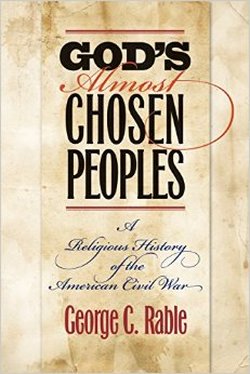
George C. Rable
The University of North Carolina Press, 2015 Paperback, 586 pp., $32.50
ISBN: 978-1-4696-2182-1
Image courtesy of amazon.com
There are many books written about many aspects of the Civil War but there was always one category which seemed to go unwritten: Religion. That is not to say that there were never any books on religion in the Civil War, but no book seemed to encompass the history of religion in the Civil War. God’s Almost Chosen People by George C. Rable attempts to fill the void of religious study in the war and throughout the text makes some provocative points. One thing can be certain when looking at a work such as this one: the monumental research provided in the pages will be seen as an advantage to have in the realm of Civil War academia.
George C. Rable holds the Charles G. Sumersell Chair in Southern History at the University of Alabama. He is the author of many other works such as Civil Wars: Women and the Crisis of Southern Nationalism, The Confederate Republic: A Revolution against Politics, and Fredericksburg! Fredericksburg! which has been hailed as the primary narrative on the Fredericksburg campaign and also won the Lincoln prize. He is also the winner of the Blackmon-Moody Outstanding Professor Award for the University of Alabama in 2003 and was the President of the Society of Civil War historians from2004-2008. This work is also part of the Littlefield History of the Civil War Era, a sixteen volume series of books from some of today’s most respected Civil War historians compiled by the University of North Carolina Press.
There have been books on the market about how religion morphed the ways in which the soldiers acted during the American Civil War, but this book takes a different approach to religion. From the opening pages all the way to the end of the narrative, this book was all encompassing and dealt with all the major issues which the war pervaded. By using the accounts and sermons from many of the influential ministers of the time to politicians using faith as a means for their ends was just fascinating on all counts. Some of the most fascinating chapters were the way in which clergy and church administrators used the Bible as a way to prove that the other side of the conflict was in the wrong by what they were doing. The section labeled “Holy War” and “War’s Purpose” really made you think about the causes of the Civil War and how it was seen as a whole. Rable also pays attention to the minority religions such as the Mormons who had undergone a great deal of harassment before the war with the Mormon wars. He also talks about the Catholic influence. This is, in my experience of Civil War research, the only full volume treatment about Religion in the Civil War while others have a much more concentrated fell to them. This was a great breath of fresh air to read as a full volume treatment.
I highly recommend this book to anyone interested in the history of religion in this county and anyone who is studying the Civil War. The only way students can fully comprehend how the Civil War morphed the way in which people used faith as not only an existential ground, but as a means to their own ends is to read this book. I applaud George C. Rable for this phenomenal work about religion and suggest that it should be on the shelf of every Civil War historian.
 RSS Feed
RSS Feed
